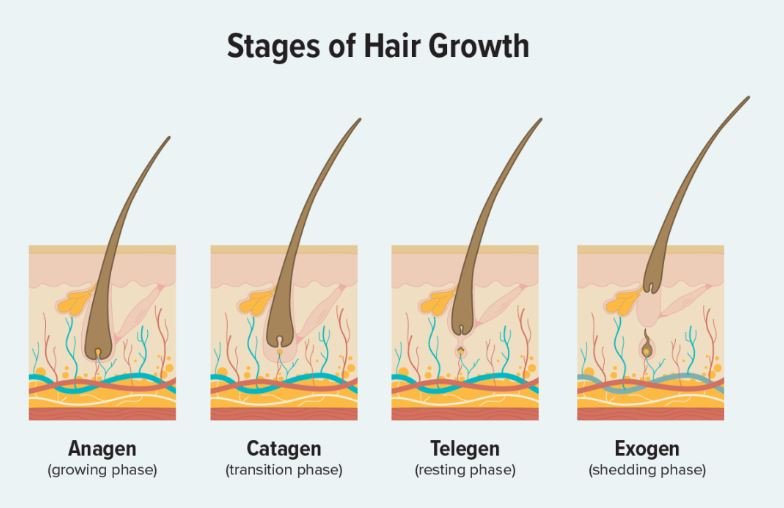Cycle of Hair Growth
The grown hair does not grow continuously, and after a certain period of time, it falls off the scalp and new hair grows back. This phenomenon is called the mother cycle. It is divided into a growth period, degeneration period, rest period, and development period.
1. Physiological structure of hair
1) Hair is a protein structure on the surface of the skin with a thickness of 0.07 to 0.1 mm and is formed from hair follicles and hair roots inside the skin.
2) The round part at the bottom of the hair root is called the capsule, and the part where capillaries and nerves are distributed and oxygen and nutrition are supplied is called the capsule.
3) Hair roots are usually fixed in the scalp at a depth of 1 to 2 mm.
4) Hair grows 0.35mm a day, and the number is said to be about 100,000 to 120,000.
5) The size of the hair follicle determines the thickness of the hair.
6) Hair cannot be produced without hair papules, and the number of hair papules is said to be determined at birth.
7) Hair papilla is a hair-making organ, but it does not continue to be active throughout its life, and it temporarily stops working after continuing to some extent, which is called planting.
Hair Growth Cycle
It is divided into 4 stages: Anagen> Catagen > Telogen > Return to anagen, and it is repeated at regular intervals depending on individual characteristics and environment.
Anagen
1) The hair bulb is located in the lower part of the dermal layer and the upper part of the subcutaneous fat layer.
2) It takes the longest time.
3) Hair grows at an average of 0.35mm per day when cell division is active in the hair follicle, and normal people have a growth period of 80 to 90%, and the growth period lasts for 3 to 6 years on average. 3 to 5 years for men and 4 to 6 years for women.
Anagen hair accounts for about 80 to 90% of the total number of hairs, and female hair is generally longer than male hair due to differences in anagen. Also, since hair in the growth phase does not fall out unless a certain amount of force is applied, the hair that falls out during shampooing is not the growth phase hair. However, when more than 100 hairs fall out when shampooing, you need to suspect hair loss.
Catagen
1) This is the stage where the hair bulb and dermal papilla are separated.
2) The hair bulb contracts the tissue and becomes as long as possible like a reinforcing bar.
3) It is a period in which hair grows very slowly due to the end of the hair cycle and cell division is reduced, and the degeneration period is about 1 to 1.5 months.
4) Hair in the catagen phase accounts for about 1% of the total number of hairs, and postpartum hair loss is characterized by going directly from the growth phase to the resting phase without going through the catagen phase.
Telogen
1) Hair follicles are atrophied and the hair bulb and dermal papilla are completely separated and do not receive nutrition.
2) This is the period when hair stops dividing after cell division, and it is about 3 to 5 months.
3) Even after cell division is over, the hair that has already grown is swollen on the scalp for about 3 to 5 months by the power of the hair root, and then is gradually pushed away.
Return to anagen
1) It is the time when the hair bulb and the dermal papilla are reunited to receive nutrition and control so that the production of keratin protein and the division and proliferation of hair matrix cells occur.
2) It is the initial state of the growth phase when the hair bulb surrounded by hair follicles combines with the dermal papilla and cells begin to divide again.
3) As new hair develops and grows, the telogen hair is pushed out of the follicle.
-The Nature Atelier-
If my article was helpful, please comment and visit my SNS. It will be a great help for me to continue running the site.
Twitter
https://twitter.com/Atelier_Eden
Instagram
https://www.instagram.com/the.natureatelier
